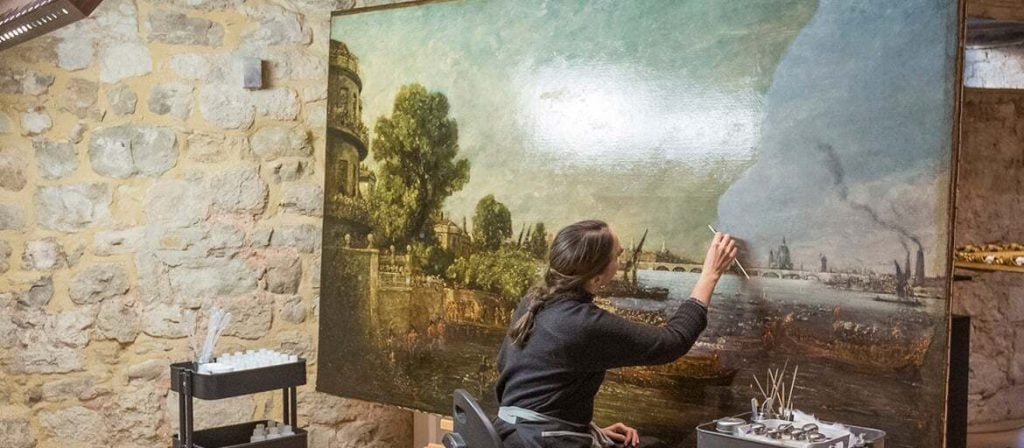Art World
Art Industry News: A Brazen Thief Made Off With Three Statues of Ai Weiwei Giving the Middle Finger in Broad Daylight + Other Stories
Plus, Belgian artist Jan Fabre gets an 18-month suspended sentence, and Documenta goes on the defensive.

Plus, Belgian artist Jan Fabre gets an 18-month suspended sentence, and Documenta goes on the defensive.

Artnet News

Art Industry News is a daily digest of the most consequential developments coming out of the art world and art market. Here’s what you need to know on this Monday, May 2.
Documenta Criticized Over Response to Anti-Semitism Allegations – The quinquennial exhibition is coming under scrutiny for its response to allegations of anti-semitism raised earlier this year. After criticism of its forthcoming program from German group Alliance Against Anti-Semitism Kassel, the show’s organizers planned a series of talks about anti-semitism, Islamophobia, and racism. But Germany’s culture minister Claudia Roth has questioned whether the focus of the talks continues to perpetuate “a clear bias against anti-semitism.” (ARTnews)
Landmark Case Recognizes NFTs as “Legal Property” – In a potentially influential ruling, the U.K.’s High Court has determined that NFTs are “property” and therefore can be subject to legal protections. The case, brought by Lavinia Osbourne, the founder of Women in Blockchain Talks, concerned two digital works she said were stolen from her online wallet. The court ruled that the assets could be frozen and that the marketplace OpenSea could be compelled to share information about the current holders of the NFTs. (The Art Newspaper)
Jan Fabre Gets 18-Month Suspended Sentence – A Belgian court has convicted the artist, choreographer, and director of bullying and violence toward five women as well as indecent assault. (He was acquitted of offenses against another woman.) He has received an 18-month suspended sentence and an order to deliver each woman symbolic compensation of €1. Fabre previously denied any wrongdoing and his lawyers maintain the charges are overblown. (The Art Newspaper)
Ai Weiwei Middle-Finger Sculptures Stolen – A sticky-fingered thief purloined three glass hand sculptures by Chinese artist Ai Weiwei from Lumas Galerie in Hamburg, Germany, in broad daylight last week. The middle-finger sculptures, which reference Ai’s long-running and controversial series “Study of Perspective,” were listed at €9,500 (£8,000) each. The gallery said the alarm protecting the works, which were stored in a back room, failed to go off. (Daily Mail)
The Guggenheim Has a Poet-in-Residence – This summer, the New York museum’s first-ever poet-in-residence, Taylor Johnson, will plant poetry in the building’s stairwells, around its grand rotunda, on columns in the cafe, and even on the sidewalk outside. The program will run from June through December. (New York Times)
Fans Petition the Postal Service to Give Gorey a Stamp – Fans of Edward Gorey, the artist, illustrator, and so-called “grandfather of goth,” are petitioning the U.S. Postal Service to release a stamp to honor his 100th birthday in 2025. Thanks to a letter-writing campaign spearheaded by the Edward Gorey House in Massachusetts, Gorey has reached the “committee stage” for consideration. (Guardian)
Cranbrook Museum Names Chief Curator – Laura Mott has been named chief curator of the Cranbrook Art Museum in Detroit. She joined the institution in 2013 as senior curator of contemporary art and design. (Artforum)
Alicja Kwade Jumps on the NFT Train – The Berlin-based artist best known for works that explore rocks, mirrors, and other very real-world materials has minted 10,361 NFTs. Each comes with a 25-page PDF filled with 300,000 letters of her own DNA code. The project is based on an earlier work, Selbstportrait, in which she printed out her entire genome on sheets of paper. The NFTs are priced at $300, or around 0.1 ETH, each. (ARTnews)
Constable Painting Transformed After Cleaning – Think you look different after a spa day? That’s nothing compared to the transformation experienced by John Constable’s The Embarkation of George IV from Whitehall: the Opening of Waterloo Bridge (1817), which recently underwent 270 hours of cleaning. The overhaul revealed a view of the Thames long obscured by varnish. It has now returned to public view at Anglesey Abbey, in Lode, Cambridgeshire. (BBC)

A conservator at work on John Constable’s largest known painting of Waterloo Bridge from 1817. Photo: James Dobson, courtesy National Trust.

Constable’s painting of the opening of Waterloo Bridge returns to Anglesey Abbey. Photo: James Dobson, courtesy of National Trust.